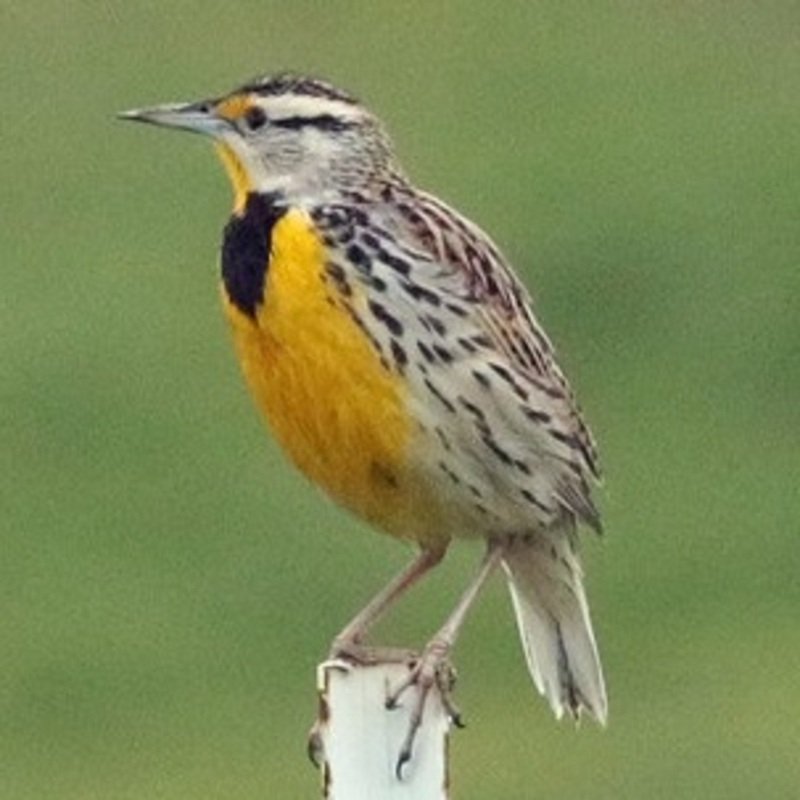The eastern meadowlark, Sturnella magna is a medium-sized icterid bird. From eastern North America to eastern South America, it is most common in the east. They belong to Icteridae family. Eastern Meadowlarks are found in farm fields, meadows, and marshy areas. They build their nests on the ground and sing from perches like as trees, fenceposts, and utility wires.
Quick Overview: Sturnella Magna – Eastern Meadowlark
Body size: Around 9-11 in (23-28 cm) and a weight of 102 g (3-6 oz)
Main colors: Black, Gray, Yellow, Brown, White
Range: Eastern United States
Migratory Bird: Yes
Best time of the year to see in the U.S.: All Year (January – December)
Conservation Status: Least Concern
Eastern Meadowlark Description
These birds have long, slender beaks and black eyes. Short, stiff tails Legs and toes: Gray heads with yellow “eyebrows” and a center stripe. Wings and tail are striped dark brown. White moustachial stripe and black breast band on males. Off-white striped flanks and tail coverts. The undertail coverts are striped dark black. More than half of all females are born in the United States. Eastern meadowlark youngsters have black and white masked regions. Winter juveniles have more brown. A reddish-brown egg with white speckles Their tails constantly twitch open. These birds glide after vigorous wing flapping.

Size
These birds have a length of 9-11 in (23-28 cm) and a weight of 102 g (3-6 oz). Their wings could range from 13.5-17 in (34-43 cm).
Feeding
Eastern meadowlarks forage for food by walking and running on the ground. Their diet fluctuates seasonally. They eat cutworms, grubs, and caterpillars in the spring. Their summer diet includes beetles and grasshoppers. In the winter, they consume weed seeds, discarded grains, wild fruits, and carrion from roadkill or predator kills.
Habitat
These birds nest in recovered strip mines, overgrown fields, and other open locations. The breeding area in the west includes tall-grass plains and desert grasslands. In the winter, they like wide fields, feedlots, and wetlands. Eastern meadowlarks inhabit more mesic areas than their western cousins.
Behavior
In the fall and winter, eastern meadowlarks form loose flocks. These flocks are made up of S. Magna and S. neglecta with no social hierarchy (western meadowlarks). They interact with other meadowlarks via singing, calling, and posing. Male eastern meadowlarks will defend against male eastern and western meadowlarks when their territories intersect. Males protect their territory through aerial displays.
Sturnella Magna Scientific Classification
- Kingdom: Animalia
- Phylum: Arthropoda
- Subphylum: Chelicerata
- Class: Aves
- Order: Passeriformes
- Family: Icteridae
- Genus: Sturnella
- Species: Sturnella magna
Best time of the year to see
In the United States, the best time of year to see these birds is all year round, regardless of the season. This refers to any month of the year between January and December.
Distribution of the Eastern Meadowlark in the USA
Breeds in southern Canada, the eastern United States, and western Arizona,; resident in the Bahamas and Mexico. Winters primarily within its breeding range.
The XXX bird can be found in the following states in the United States – Alabama, Arkansas, Connecticut, Delaware, Florida, Georgia, Illinois, Indiana, Iowa, Kansas, Kentucky, Louisiana, Maine, Maryland, Massachusetts, Michigan, Minnesota, Mississippi, Missouri, Nebraska, New Hampshire, New Jersey, New York, North Carolina, North Dakota, Ohio, Oklahoma, Pennsylvania,,Rhode Island, South Carolina, South Dakota, Tennessee, Texas, Vermont, Virginia, West Virginia, and Wisconsin.

